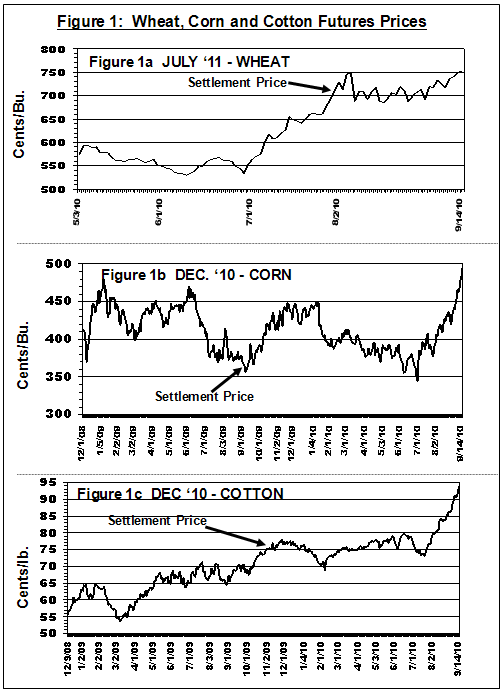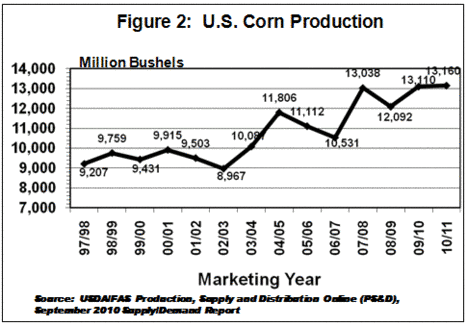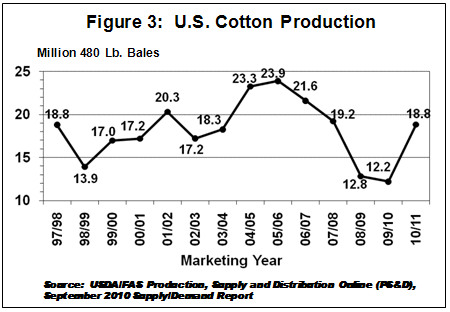Vol. 26, Issue 26, September 15, 2010 – PDF version
Jose G. Peña, Texas AgriLife Extension Economist-Management
As the corn, sorghum and cotton harvests in Texas continue to gain momentum, grain and cotton markets have improved significantly (see figure 1), as USDA lowered the corn production estimate, increased exports and lowered corn, cotton and wheat ending stocks. Earlier, it appeared that the market improvement was related to market spill-over from the surge in wheat prices as a severe drought, record high temperatures and extended wildfires in Russia and several other wheat producing former Soviet Union countries, caused a shortage of wheat. Russia imposed a ban on exports to insure domestic supplies. The market rally continued as USDA lowered the U.S. corn production estimate, increased the estimate of exports and lowered grain and cotton ending stocks.
The 2010 U.S. corn crop is now forecast at 13.16 billion bushels, 205 million bushels lower than the August forecast. USDA lowered the average yield to 162.5 bu./ac., down 2.5 bu./ac. from the initial record forecast of 165.0 bu./ac in August and down 2.2 bu./ac. from the record of 164.7 bu./ac in 2009.
Futures prices for most cotton and grain futures contracts have shown a significant improvement. December 2010 corn futures contracts closed at $4.96/bu. on Tuesday (09.14.10) after dipping to about $3.44/bu. in late June 2010. (See Figure 1b). December 2010 cotton futures prices closed at about 91.8 cents/lb. on Monday, up about 17 cents from recent lows of about 74 cents in early-July. Prices were up again on Tuesday (09.14.10) to 94.5 cents, the highest since early 2008 when speculators/fund investors moved cotton futures prices to over $1.00/lb. (See Figure 1c). It appeared that the market rally may continue.
Meanwhile the livestock industry is expressing serious concerns from signals of higher feed costs. Futures prices for live and feeder cattle contracts have shown significant weakness from recent mid-August 2010 highs.
Corn
USDA’s September 10, 2010 supply/demand report lowered U.S. carry-in stocks and reduced production for corn and sorghum. The decreased corn production estimate was primarily based on reducing the average yield/acre to 162.5 bu./ac., down 2.5 bu./ac. from last month’s record estimate of 165.0 bu./ac. Beginning stocks were reduced by 40 million bushels as a result of a higher 2009/10 corn use for ethanol and a small increase in exports from last year’s crop.
While the estimate of U.S. corn production at 13.16 billion bushels is down 205 million from last month’s forecast, it is still the largest crop on record (See Figure 2). The largest reductions in forecast yields are for the eastern Corn Belt, which account for more than half of the reduction in total output.
U.S. domestic use was lowered 100 million bushels from last month’s estimate with lower expected feed and residual use as higher prices may reduce feeding demand. Projected U.S. exports were raised 50 million bushels with rising world demand for coarse grains, particularly corn.
U.S. corn ending stocks are expected to decline to 1.1 billion bushels, down 196 million bushels, from last month’s estimate and down 270 million bushels from beginning stocks of 1.386 billion bushels. At this level, 2010/11 carryout would be the lowest since 2003/04. Stocks as a percentage of total use is expected to be the lowest since 1995/96.
The season-average farm price is projected at $4.00 to $4.80 per bushel, compared with $3.50 to $4.10 last month.
Cotton
USDA’s September 10, 2010 supply/demand report indicated higher U.S. cotton production, domestic mill use, and exports relative to last month. Production of 18.8 million bales is nearly two percent above last month’s estimate and is based on increases across all regions of the cotton belt. Domestic mill use was raised to 3.6 million bales, reflecting recent increases in consumption rates and prospects for additional spinning capacity. Exports were raised 500,000 bales to 15.5 million due to continued very tight foreign supplies, especially in China where excessive rain has continued to devastate their cotton crop.
U.S. ending stocks are now forecast at 2.7 million bales, 500,000 bales below last month. If realized, both the stocks level and the stocks-to-use ratio of 14 percent would be the smallest since 1995/96. The average price received by producers is forecast at 63 to 77 cents per pound, twp cents above last month. The midpoint of the interval, 70 cents per pound, would also be the highest price since 1995/96.
Appreciation is expressed to Dr. Jackie Smith, Extension Economist for his contribution to and review of this article.



